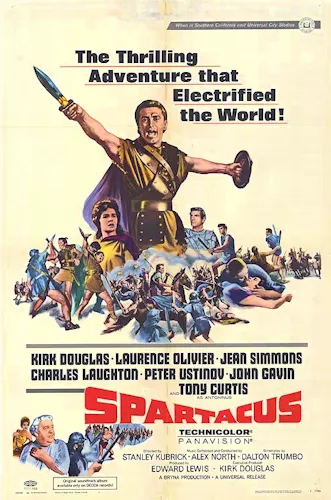Historical accuracy of Spartacus

Historical accuracy of Spartacus

Characters
Spartacus
Spartacus was the real leader of the Third Servile War. However, historical details about him are scarce. The film portrays him as an idealized freedom fighter, adding fictional motivations and relationships.
Varinia
Varinia is a fictional character created for Howard Fast's novel and the film. There is no historical record of Spartacus having a wife or lover named Varinia accompanying the revolt.
Marcus Licinius Crassus
Crassus was the real Roman commander who eventually defeated Spartacus. The film accurately portrays his wealth and ambition, but his personal motivations, interactions, and specific tactics are heavily fictionalized.
Gracchus
This character, representing opposition to the Senate oligarchy led by Crassus, is fictional. He may be inspired by earlier figures like the Gracchi brothers, but his role in the film has no direct historical basis.
Lentulus Batiatus
The revolt did begin at the ludus (gladiator school) owned by Gnaeus Lentulus Batiatus in Capua. His characterization in the film is dramatized.
Antoninus
Antoninus is a fictional character. His devotion to Spartacus, background as a poet, and relationship with Crassus are all dramatic inventions.
More characters
Julius Caesar
Caesar was alive during the revolt but was a junior figure with no significant military command in suppressing Spartacus, unlike his prominent role in the film's latter half.
Crixus
Crixus was a real and important leader in the slave army alongside Spartacus. His historical role and eventual separation/defeat are accurately reflected in broad strokes.
Tigranes Levantus
Represents the Cilician pirates with whom Spartacus negotiated for passage. The specific name and characterization are likely fictional, but the negotiation event is historical.
Marcellus
A fictional character representing the harsh trainers within the gladiator schools.
Draba
A fictional character created for a key scene demonstrating solidarity and defiance among the gladiators before the revolt begins.
Story
Revolt begins at Batiatus's ludus in Capua
The Third Servile War did indeed begin with a breakout of gladiators from Batiatus's school in Capua in 73 BC.
Rebels initially based on Mount Vesuvius
The escaped slaves first established a base on Mount Vesuvius, where they gathered more followers.
Early victories against Roman forces (Glaber, Varinius)
Spartacus's forces defeated several poorly prepared Roman militia and legionary forces sent against them in the early stages of the revolt.
Spartacus's army marches through Italy, numbers swell
The slave army grew significantly as it moved through Italy, attracting runaway slaves and discontented rural poor.
Division in rebel army / Crixus splits off and is defeated
Historical sources describe divisions among the rebels, with Crixus leading a faction that separated from Spartacus and was subsequently defeated and killed by Roman forces.
Spartacus marches north to Alps, then turns south
Spartacus did defeat legions in the north near Mutina (modern Modena) and could have left Italy, but inexplicably turned south again. His reasons remain debated by historians; the film offers no reason.
Negotiations with Cilician pirates for passage to Sicily
Historical accounts state Spartacus attempted to arrange passage to Sicily with Cilician pirates.
Pirates betray Spartacus
The pirates took payment but failed to provide the promised ships, effectively betraying Spartacus, possibly due to Roman pressure or bribes as the film suggests.
Crassus traps Spartacus's army in Bruttium (Southern Italy)
Crassus constructed extensive fortifications across the toe of Italy to corner Spartacus's army.
Final battle and defeat of Spartacus's army by Crassus
Spartacus's army was decisively defeated by Crassus's legions in Lucania in 71 BC. Spartacus himself died in the battle.
Mass crucifixion of 6,000 captured slaves along Appian Way
Crassus crucified thousands of captured slaves along the Appian Way from Capua to Rome as a brutal warning.
Spartacus's relationship with Varinia
The entire romantic subplot involving Varinia is fictional.
Gracchus's political schemes and suicide
The character of Gracchus and his political machinations against Crassus, alliance with Batiatus, and suicide are entirely fictional.
I'm Spartacus! scene
This iconic scene is purely fictional, created for the film to emphasize solidarity. Spartacus died in the final battle, and Crassus likely wouldn't have needed to identify him among captives.
Varinia and child escape to freedom
Since Varinia is fictional, her survival and escape with Spartacus's (also fictional) child, facilitated by Batiatus and Gracchus, did not happen. The fate of any real family Spartacus might have had is unknown.
Setting
Roman Republic Italy, 73-71 BC
The film is correctly set during the time and place of the Third Servile War in the late Roman Republic.
Gladiator School (Ludus) in Capua
The film provides a visually strong (if perhaps sanitized by 1960 standards) depiction of a Roman gladiator training school, reflecting the harsh conditions.
Roman villas and aristocratic life
Sets depicting the luxurious villas and decadent lifestyle of the Roman elite like Crassus contrast effectively with the slaves' conditions, reflecting Roman social stratification.
Italian landscapes (Vesuvius, countryside, Southern Italy)
Filmed largely in Spain and California, the locations effectively represent the varied Italian terrains where the revolt took place, from Vesuvius to the southern peninsula.
Roman military camps and fortifications
Roman legionary camps and Crassus's fortifications in Bruttium are visually represented, reflecting Roman military engineering.
Roman Legionary equipment
The armor (lorica segmentata - technically slightly anachronistic for 70s BC, but standard Hollywood depiction), helmets, shields (scutum), and weapons (gladius) of Crassus's legions appear visually consistent for a 1960 film.
Gladiatorial equipment
The various types of gladiator armor and weaponry used in training and combat scenes appear appropriately diverse for different gladiator types shown.
Depiction of Roman slavery
The film portrays the brutality and pervasiveness of slavery in the Roman Republic, which was the underlying cause of the revolt.
Crucifixion along the Appian Way
The final scenes visually represent the mass crucifixion ordered by Crassus, a historically accurate and brutal method of Roman execution for slaves and rebels.
Roman Senate / Political settings
While specific Senate scenes are few, the dialogue and actions of characters like Crassus and the fictional Gracchus represent the political maneuvering within the Roman Republic's elite.
